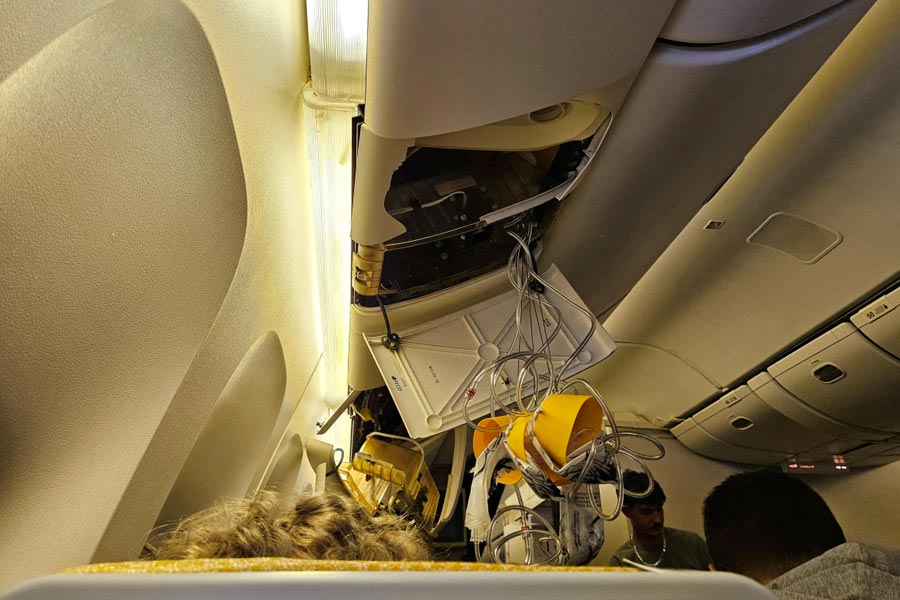The Singapore Airlines (SIA) Flight SQ321 that was rocked by severe turbulence on Tuesday climbed and descended rapidly twice in 62 seconds, stunning the passengers with one dying of heart attack, as the aircraft flew over the Irrawaddy Delta region of Myanmar, it emerged on Saturday.
One passenger -- 73-year-old Briton Geoffrey Kitchen -- died, and dozens were injured in the incident. It is the first SIA aviation accident involving a fatality since the SQ006 crash in Taiwan in October 2000.
As the flight, which was heading to Singapore from London, experienced sudden severe turbulence over the Irrawaddy Basin during the breakfast service, the pilot declared a medical emergency and diverted the plane carrying 211 passengers and 18 crew members to Bangkok’s Suvarnabhumi Airport, where the plane made an emergency landing at 3.45 pm (4.45 pm Singapore time).
Granular flight data from flight tracking website Flightradar24 shows that the Boeing 777-300ER climbed and descended rapidly twice in 62 seconds, starting from 3:49 pm Singapore time, as the plane was nearing the end of a non-stop flight from London to Singapore, The Straits Times newspaper reported.
During this time, the plane climbed from its cruise altitude of 37,000 feet to 37,400 feet and then dropped to 36,975 feet before settling back onto its cruise altitude.
This indicates that it was the rapid transition between the climb and descent caused by the turbulence – and not the actual change in altitude itself, which was relatively minor – that caused pandemonium in the cabin.
The Flightradar24 data – derived from a global network of ground-based receivers, satellites and radars that receive flight data from aircraft transponders – contradicts some earlier reports, which pinpointed the aircraft descending from 37,000 feet to 31,000 feet between 4.06 pm and 4.10 pm as the cause of the injuries.
This latter transition appears to be the pilots carrying out a controlled descent, most likely to assess the situation before diverting to Bangkok, according to the broadsheet report citing a commercial pilot who has flown both civil and military multi-engine passenger aircraft for more than 20 years.
Speaking on condition of anonymity, the pilot said the rapid climb would have introduced positive G-forces onto passengers, causing sitting passengers to feel like they have been pinned down in their seats.
The subsequent rapid descent would have resulted in negative G-forces, which would have sent unrestrained passengers and other loose items hurtling upwards onto the ceiling of the cabin, he added.
The embattled plane went through another cycle of rapid climb and descent, causing more damage and injuries, with some passengers and objects hitting the roof panels and overhead lockers before being flung back down.
This is reflected in the accounts of passengers on board SQ321 who reported being thrown onto the cabin roof, with Australian passenger Teandra Tukhunen recounting that she was abruptly woken up when she was thrown to the roof and then to the floor.
The G-force data would have been captured by the quick access recorder fitted onboard the aircraft. This is a flight data recorder designed to provide quick and easy access to raw flight data through means such as USB or mobile phone networks.
The Flightradar24 data showed that the Boeing 777 first attained a climb rate of 1,664 feet per minute (fpm) – or 507m per minute, double the height of 52-storey Capital Tower – before descending at 1,536fpm six seconds later. It rapidly returned to a climb rate of 900fpm a mere three seconds later, and then descended at 1,536 fpm after another 10 seconds.
Transport Minister Chee Hong Tat said on Friday that investigators from Singapore’s Transport Safety Investigation Bureau are going through data from the cockpit voice recorder and the flight data recorder.
The United States National Transportation Safety Board’s data from 2009 to 2018 showed that passengers injured in turbulence-related accidents were most often using, waiting for or walking to or from the toilet. The second-most common group was passengers who were seated but not belted up.
Except for the headline, this story has not been edited by The Telegraph Online staff and has been published from a syndicated feed.










